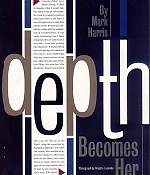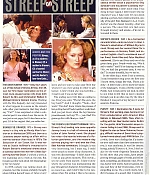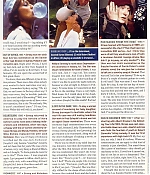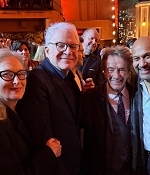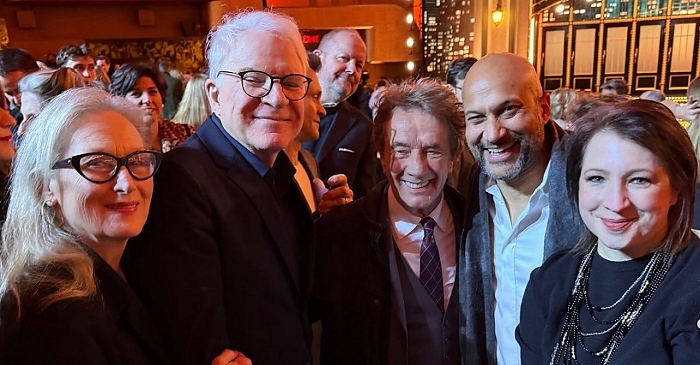|
Simply Streep is your premiere source on Meryl Streep's work on film, television and in the theatre - a career that has won her the praise to be one of the world's greatest working actresses. Created in 1999, we have built an extensive collection to discover Miss Streep's body of work through articles, photos and videos. Enjoy your stay.
|
Celebrating
25 years
of SimplyStreep
|
|
Depth Becomes Her
Entertainment Weekly ·
March 24, 2000
· Written by Mark Harris
|
“I think I was a strange child,” says Meryl Streep. “I liked to imagine I was an old woman. So I took my other’s eyebrow pencil and drew in the lines. I have this picture of this 10-year-old, huddled in a chair, with the saddest sort of weathered face. It was really interesting that I liked doing that then. It wasn’t that I was sad – I was just getting into character.” Meryl Streep has been getting into character ever since – more fulfillingly than any movie actress of our era. After 28 years and 27 feature films, she won her 12th Academy Award nomination this year for “Music of the Heart”, tying the record set by Katherine Hepburn. Yet when the actress, who married sculptor Don Gummer in 1978, looks back on her films, she’s more likely to mark them by the ages of her four children (20 t 8) than by awards she’s won. EW asked her for the highlights:
The Deer Hunter
1978. Only four years out of Yale School of Drama, Streep, then 29, won her first Oscar nomination as the almost mute, abused woman who loves both Robert De Niro and Christopher Walken in Michael Cimino’s Vietnam drama
“Working with De Niro [helped]… he’s very interested in what happens in a scene as the camera rolls, after your instinct is that they should say ‘Cut!’ I was surprised at what a substantial part it was when I saw the movie. It was just seven pages, but it does have an impact. It’s in her neglect that you notice her.”
Kramer vs. Kramer
1979. Streep won raves in a tiny role as Woody Allen’s lesbian ex in “Manhattan” (1979) and then as a Louisiana lawyer having an affair with a married senator (Alan Alda) in 1979’s “The Seduction of Joe Tynan”. But it was her role as Dustin Hoffman’s troubled ex in Robert Benton’s emotional drama about a custody battle that won her a Best Supporting Actress Oscar.
“I worked a week at the beginning and a week at the end. But (laughingly) they talk about me disparagingly for two hours! In 1979, nobody was talking about depression, but this woman probably thought about killing herself once or twice every day. I could understand the compulsion to leave and not want to take your little boy wherever you were going in order to get better. I didn’t think she was horrible – I read it and I was on her side. The ending never felt like and ending to me. Everyone said, ‘There! She gave the boy back!’ And I thought, ‘Yeah… that week’. You don’t know where the process of ger getting herself back together would lead. And you just know when the boy became preadolescent, he’d say ‘F– you, Dad! I’m gonna live with my Mom, a-hole!”
The French Lieutenant’s Woman
1981. Streep’s first leading role came opposite Jeremy Irons in a hail-of-mirrors adaptation of John Fowles’ novel. She played two roles – the haunted mistress of a Victorian gentleman, and the modern-day actress playing her – an won her first Best Actress nomination.
“I thought it was very interesting, but I must say, I could never attach to either of my characters ever. It was very disconcerting – I didn’t know who I was at any given moment. This movie… set me aside from myself. I didn’t know where the actress was manipulating the guy through her character. Everything was so conscious, and I don’t like to be conscious when I’m acting. I like to be unconscious – extremly unconscious.”
Still of the Night
1982. Streep reteamed with Robert Benton in an unsuccessful thriller about a psychatrist (Roy Scheider) and his patient’s possibly murderous mistress.
“I didn’t know what I was doing in that. Again, I had no idea who my character was. I hate noir. It’s not about playing a person, but a represenation, usually of the girl. Kim Basinger in “L.A. Confidential” was the closest recently – that was a person. The ones that are just seen through mystery and smoke – I’m not interested in them.”
Sophie’s Choice
1982. As a tormented concentration-camp survivor in Alan J. Pakula’s adaptation of William Styron’s novel, Streep won her second Oscar for a performance – in German, Polish and accented English – that’s considered one of her finest. Kevin Kline and Peter MacNicol costarred.
“Kevin and Peter are two of the great funny guys. People would say, ‘Was it sad to make?’ and I’d be chirping on and on, ‘No, we had the greatest time, it was so fun!’ It sounds dreaful, but we had to. In the olden days, when I had a memory, I could remember song lyrics from the first time I heard them, things like that. That’s a facility – it didn’t take a lot to learn the sound of the languages. I took a Berlitz course in Polish. And I read poetry out loud, in order to see what it felt like to move emotion through you in an alien way. By the time I finished, it was part of my larynx; it wasn’t separate from me.”
Plenty
1985. Nomination No. 5 came for Streep’s first working-class heroine in her first collaboration with director Mike Nichols, in “Silkwood” (1983). Then, after reuniting with her Deer Hunter costar De Niro for the gentle, Brief Encounter-esque romance “Falling in Love” (1984), Streep went to England to star as Susan Traherne, the angry, difficult heroine of David Hare’s play-turned-movie about post WWII-Britain.
“For a while, there was a feeling that if a character ever said more than three sentences in a row, it was anathema. It was like theater, boring, nobody’ll listen to it. Now, I don’t really love the work of Quentin Tarantino, but he did show that you could… have people plowing through pages of words, and still be dark, compelling, and filmically valid. ‘Plenty’ was loaded with words. And her passion, the size and fury of her frustation, were so compelling to me. It’s a wordy movie, but I did it because of a speech that I wanted to say. I just wanted to say, ‘I would stop, I would stop, I would stop f***cking talking if I every heard anybody else say anything else worth f***ucking stopping talking for!”
Out of Africa
1985. Streep won her sixth Best Actress nomination as the Danish writer Isak Dinesen in Sydney Pollack’s lush romantic epic.
“Right after ‘Plenty’, I dyed my hair dark, and we flew from England to Africa. For six months we lived there. It was fantastic. My son spent the second half of first grade there. You know there are different styles in motion pictures. There was a time when nobody ever wanted to have narration over anything. I remember Sydney saying, ‘Oh, my God, we can’t seem to find any other way! I hate voice-overs, they’re horrible, pedestrian, the worst kind of filmmaking!’ Well, now most of the cutting-edge movies all have voice-over narration. But in the 70’s and early 80’s, it wasn’t considered ‘pure’. I’d say, Gee, Orson Welles did well with it, you know?”
Heartburn
1986. Streep returned to America to play the heroine of Nora Ephron’s comic novel about Beltway indiscretions and infidelities. After two days, unhappy with the on-screen chemistry between Streep and Mandy Patinkin, director Mike Nichols replaced him with Jack Nicholson.
“How was it? Scary. [Nicholson] terrified me. He was Jack Nicholson! [laughs] I only became ’emeritus’ recently, and he’s been that for years. He was a force of nature, very, very funny, a friend of Mike’s, and so I thought, ‘is there gonna be room for me?’ There was… I was pregnant again. I got pregnant in Africa. And I got really, really sick, with something African! [laughs] So I look at ‘Heartburn’ and all I can see is my green, green, green face.”
Ironweed
1987. Streep and Nicholson quickly reteamed on an adaptation of William Kennedy’s novel about Depression era alcoholics in Albany, N.Y. The film won Oscar nominations for both of them.
“It was very cold. Just f–cking cold. You cannot imainge how cold. And I had a little cloth coat. I had a profound understanding of what it was like to spend the night outdoors, because we shot all night in Albany in February. I’d come home to Connecticut at four or five in the morning. I have a very light-filled house. So I would sleep in the closet, because it was the only place that was dark and (laughs) where the kids couldn’t find me.”
A Cry in the Dark
1988. To play a woman accused of murdering her baby daughter, Streep journeyed to Australia, where the real-life case was still making headlines. Her work in Fred Schepisi’s drama won her an eight Oscar nomination.
“There were enormous legal considerations over every line I said, because Lindy Chamberlain was pressing the government to be exonerated. Along with all the other challenges of making a movie, to have lawyers sitting there… There was no doubt in my mind that she was innocent. And they did exonerate her, after the film. But because of her manner, she was condemned. She wasn’t the weeping, screaming, bereaved mother – she was more like ‘None’a your f–ucking business how I feel!’ There are people you just want to tell, ‘You know, you’ll get further in life if you just…’ (laughs) She was vilified for the shape of her eyebrows, because they pointed down and she looked mad all the time.”
Postcards from the Edge
1990. Streep teamed with Roseanne in 1989’s unsuccessful comedy “She-Devil” (“That [had been] and incredible BBC series – but I think they were affraid they would scare men off with a Jacobean-feminist revenge drama. Men didn’t go anyway, so why pander?”) She then won her ninth nomination as the frazzled heroine of Carrie Fisher’s comic showbiz novel; th erole gave her a chance to belt out a country sond at the end.
“That was cool! Isn’t that your fantasy? To be up in front of a couple of electric guitars in a rock’n roll band? That was mine! I was Bonnie Raitt for a day. It was the last day of shooting and they were having a party, and there was real food and real beer out there, and I knew if I did it, I could go to the party. It was the first movie I did in Hollywood. The only time I’d been out there was for award ceremonies. I’d get nauseous every time we’d come over the mountains and see Los Angeles – I’d think ‘Ohhhh, my God, I’ve gotta get my dress on…”
Death Becomes Her
1992. After co-starring with Albert Brooks in his “Defending your Life” (1991), Streep was cast opposite Goldie Hawn as a vain, viperish actress who finds the fountain of youth in Robert Zemeckis’ biting comedy. It was her first experience with high-tech F/X.
“My first, my last, my only. I think it’s tedious. Whatever concentration you can apply to that kind of comedy is just shredded. You stand there like a piece of machinery – they should get machinery to do it. I loved how it turned out. But it’s not fun to act to a lampstand. ‘Pretend this is Goldie, right here. Uh, no, I’m sorry, Bob, she went off the mark by five centimeters, and now her head won’t match her neck!’ It was like being at the dentist. I thought that movie was a documentary about the Los Angeles fixaction with aging… Women treat themselves that way because we’re given power based on how we look – never mind Margaret Mead.”
The Bridges of Madison County
1995. After appearing wiht Glenn Close and Winona Ryder in an adaptation of Isabel Allende’s “The House of the Spirits” (1994) and Curtis Hanson’s action film “The River Wild” (1994), Streep won the decade’s most sought-after female role – and her 10th Oscar nomination – in Clint Eastwood’s adaptation of the Robert James Waller best-seller.
“I had a picture of who this was – I knew it was an Italian war bride, and I had grown up down the street from one. Her husband was a tall, blond man, and she barely spoke any English. Over the years she learned – she was a very bright, interesting woman – but there was always something exotic about her. Anyway, the book had this woman in jeans and braless. It was just hard for me to understand her. I had a pretty vivid picture of her, and I didn’t want to complicate it (laughs) with the authors actual intent. I honestly didn’t finish the book. I started it and then thought, I’ll wait for the screenplay. The screenplay had a woman in it.”
Before and After
1996. Streep and Liam Neeson played the parents of a teenage boy accused of murder in a dour drama directed by Barbet Schroeder.
“Barbet has done beautiful work. But… I found it difficult. Liam and I had a blast, but it was a stultifying experience. One of the things was that Barbet insisted that words not ever overlap. Everybody had to finish what they were saying. Then the other person would start. It sucked the life out of the scenes for us – he made an airless thing.”
Marvin’s Room
1996. As the freewheeling sister of a seriously ill woman (Diane Keaton), Streep got to share scenes with her old costar Robert De Niro – and played mother to Leonardo DiCaprio.
“I finally got some credibility in my own household when Leo called me ‘da bomb’. I thought ‘da bomb’ was a bad thing, but no. On ‘Marvin’s Room’ I realized that I learn from De Niro all the time. And my mother used to say, ‘on a multiple-choice test, your first choice is generally right.’ And Bobby’s all about doubting himelf, saying ‘let me do one more, one more’. He can give a director and an editor an infinite variety of choices. And I’m more one to say, ‘Look, I have to go home and cook dinner for 12 people and I CAN’T BE HERE ANYMORE'”
Dancing at Lughnasa
1998. Streep played one of five Irish sisters in a gentle adaptation of Brian Friel’s hit play.
“After Yale, I did play after play after play. I loved it! And then I stopped – all on behalf on my children who don’t appreciate my sacrifice AT ALL! (laughing) ‘Eeuuuwww, theater, why would you want to do that? It’s boring!’ I really miss it… So that was the main thing. To begin circling the theater, to see if I could fit my large, overly important self into an ensemble again in the way that everybody does seamlessly in the theater. And they were amazing to me, forgiving and welcoming.”
One True Thing
1998. Streep’s 11th Oscar nomination came for one of her most moving recent performances – as a cancer-stricken housewife and mother in an adaptation of Anna Quindlen’s novel.
“I was talking to Anna Quindlen the other day, and she said, ‘I couldn’t get over how nice you were to my kid on the set the day you were about to go up to the bedroom and do the pivotal emotional scene.’ But I was so glad she brought her kid on the set, I was so glad I had something else to think about, because these feelings are so dangerous. As an actor, sometimes you do everything you can to push a feeling away from you, because you don’t have to work for it. It’s too accessible, it’s all right there, and you’d better damn well do your best to think about lunch or complain about your wardrobe. It was like the choice scene in ‘Sophie’s Choice’. I read that scene once when they gave me the script. I didn’t ever want to look at it. I knew what that was going to be. I didn’t have to practice. You don’t want to make any connections to your own life – just don’t go there.”
Music of the Heart
1999. As a last-minute replacement for, of all people, Madona, Streep stepped in to play innercity violin teacher Roberta Guaspari for director Wes Craven, and won her 12th nomination.
“That came to me late. I had to beg them to give me some more time for the violin part of it. The gift was working with these children, who were endlessly inventive. It was like an acting primer; and it was the thing I didn’t expect. I was totally the boss! They didn’t listen to Wes Craven at all. He’d say, ‘Meryl, can you please…’ and I’d say, ‘Awrighawrightawright! Everybody shut up!’ And I thought, ‘Hmmm. Maybe I could direct!'”


